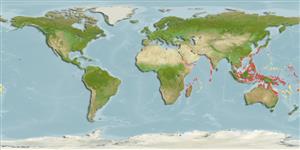>
Gobiiformes (Gobies) >
Gobiidae (Gobies) > Gobionellinae
Etymology: Mugilogobius: Latin, mugil, -ilis = grey mullet + Latin, gobius = gidgeon (Ref. 45335).
Eponymy: Dr Hugo Philip Ralph Merton (1879–1940) was a German zoologist and explorer. [...] (Ref. 128868), visit book page.
More on author: Weber.
Environment: milieu / climate zone / depth range / distribution range
Écologie
marin; eau douce; saumâtre benthopélagique; amphidrome (Ref. 46888); profondeur 0 - 5 m (Ref. 86942). Tropical (Ref. 13275)
Indo Pacific: from South Africa and Seychelles up to Japan, Pakistan, to the Indo-Malaysian archipelago, Papua-New Guinea, New Caledonia, Vanuatu, Australia and Santa Cruz Islands (Ref. 97791).
Taille / Poids / Âge
Maturity: Lm ? range ? - ? cm
Max length : 6.0 cm SL mâle / non sexé; (Ref. 57749)
Description synthétique
Clés d'identification | Morphologie | Morphométrie
Épines dorsales (Total) : 7 - 8; Rayons mous dorsaux (Total) : 6 - 8; Épines anales: 1; Rayons mous anaux: 6 - 8; Vertèbres: 25 - 27. Diagnosis: A moderate to large Mugilogobius with second dorsal and anal fin with 1 spine and 6-8 rays; pectoral fin rays 14-17; longitudinal scales 26-37; 12-16 circumpeduncular scales; predorsal scales 9-19, mostly small, central anteriormost scale immediately behind eyes always largest, anteriormost one to four scales larger than those posterior to them; scales on body mostly ctenoid; third spine of first dorsal fin most often longest; body brownish with 7-11 darker narrow diagonal bars, chevrons or X-shaped markings along sides, interspaces between chevrons or bars pale, forming chequered or banded pattern, two to three dark spots or short diagonal bars on caudal base (Ref. 43716).
Facultative air-breathing in the genus (Ref. 126274); Mainly recorded from mangroves and estuaries, but also found in coastal freshwater streams (Ref. 43716).
Life cycle and mating behavior
Maturité | Reproduction | Frai | Œufs | Fécondité | Larves
Larson, H.K. and E.O. Murdy, 2001. Eleotrididae. Sleepers (gudgeons). p. 3574-3577. In K.E. Carpenter and V. Niem (eds.) FAO species identification guide for fishery purposes. The living marine resources of the Western Central Pacific. Vol. 6. Bony fishes part 4 (Labridae to Latimeriidae), estuarine crocodiles. FAO, Rome. (Ref. 42913)
Statut dans la liste rouge de l'IUCN (Ref. 130435: Version 2024-1)
Menace pour l'homme
Harmless
Utilisations par l'homme
Outils
Articles particuliers
Télécharger en XML
Sources Internet
Estimates based on models
Preferred temperature (Ref.
123201): 25 - 29.3, mean 28.5 °C (based on 2341 cells).
Phylogenetic diversity index (Ref.
82804): PD
50 = 0.5000 [Uniqueness, from 0.5 = low to 2.0 = high].
Bayesian length-weight: a=0.00977 (0.00444 - 0.02153), b=3.04 (2.85 - 3.23), in cm total length, based on LWR estimates for this (Sub)family-body shape (Ref.
93245).
Niveau trophique (Ref.
69278): 3.5 ±0.4 se; based on size and trophs of closest relatives
Résilience (Ref.
120179): Haut, temps minimum de doublement de population inférieur à 15 mois (Preliminary K or Fecundity.).
Fishing Vulnerability (Ref.
59153): Low vulnerability (10 of 100).
